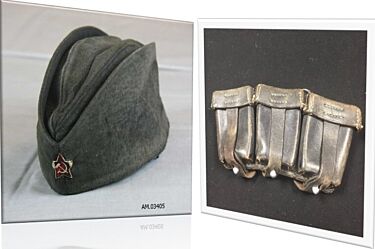
Object of the month: Military effects from World War II
Military effects from World War II
This autumn, Alta Museum marks the 80th anniversary of the forced evacuation of Finnmark and North Troms, and the liberation of Eastern Finnmark. These items are Soviet and German military effects from World War II. The hat is a Soviet soldier's hat belonging to a summer uniform. The cartridge bag is of German origin, and has been used here in Alta.
Norway was occupied by Germany during World War II, from 9th April 1940 to 8th May 1945. However, the liberation of Eastern Finnmark was carried out by Soviet soldiers, called the Red Army, as early as the autumn of 1944. Towards the end of the war, it became clear that the Allies were going to win. The Allies consisted of an alliance of the United Kingdom, the United States and the Soviet Union, among others. In October 1944, the Red Army attacked the German positions on the Arctic front along the River Litsa east of Petsamo, and advanced further into Finnmark.
After fighting hard battles against the German forces in Kirkenes, the Red Army liberated the town and continued their advance some distance west until they stopped at the Tana River. At the same time, the civilian population in Finnmark and North Troms was forcibly evacuated to further south in Norway, while the Germans carried out the scorched earth – tactic westwards from Tana to the Lyngenfjord.
The remaining parts of Norway was liberated on the 8th May 1945.